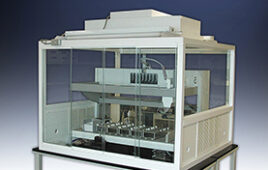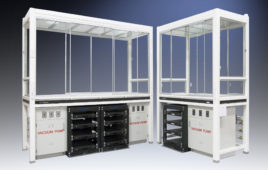 North Dakota State University has dissolved its Center for Nanoscale Science and Engineering, due to a lack of funding. Operations ceased as of Sept. 30 — most employees found work elsewhere on the NDSU campus, while others found jobs in private industries.
North Dakota State University has dissolved its Center for Nanoscale Science and Engineering, due to a lack of funding. Operations ceased as of Sept. 30 — most employees found work elsewhere on the NDSU campus, while others found jobs in private industries.
However, the center will continue to host research projects, and the cleanroom will be used in at least four classes, according to a published interview with Kelly Rusch, NDSU vice president for research and creative activity.
According to Valley News, former North Dakota Senator Byron Dorgan is puzzled as to why the school closed the center, after he helped them secure over $140 million dollars in federal funding for CNSE between 2002 and 2010. The school has retorted that the center is not entirely closed. Dorgan has called the closure “a major loss of a great opportunity for NDSU.”
Controlled Environments published a case study of the facility back in 2005. Read more: Case Study: Designing a Nanoscale Science and Engineering Center
The 14,500 sq. ft. cleanroom wing features 8,000 sq. ft. of service chase, and 4,100 sq. ft. of Class 10,000 and 2,300 sq. ft. of Class 100 cleanrooms for microsensors and nanotechnology research, plus traditional semiconductor processes. The center utilizes the cleanrooms for electronic miniaturization research and fabrication. The cleanrooms contain photolithography, wet chemistry and thin film deposition technology.
The facility was founded in 2002, and it was used to develop coatings for Navy ships and ground sensors that were deployed in Iraq, in addition to other projects. But funding started decreasing for the center in 2011, after Congress banned earmarks — earmarks are funds given by Congress for projects, programs, or grants where the purported congressional direction (whether in statutory text, report language, or other communication) circumvents otherwise applicable merit-based or competitive allocation processes, or specifies the location or recipient, or otherwise curtails the ability of the executive branch to manage its statutory and constitutional responsibilities pertaining to the funds allocation process.
The center had to apply for small competitive grants after that, but it was not enough. The research group was posting 10 to 12 articles per year at its peak, and now it’s down to about six or seven. New hires ceased in 2012, and workers were laid off. Without proper funding and workers to operate the machinery, the lab equipment may grow stagnant from lack of use, and there isn’t enough money to buy new tools.
North Dakota State University was one of the institutions who, in April of this year, received part of a $3.8 million grant from the U.S. Department of Agriculture’s National Institute of Food and Agriculture. NDSU’s share was $149,714. The school also received a portion of the National Science Foundation’s $81 million for its National Nanotechnology Coordinated Infrastructure. This announcement, from September 2015, partners NDSU with the University of Minnesota Twin Cities.




